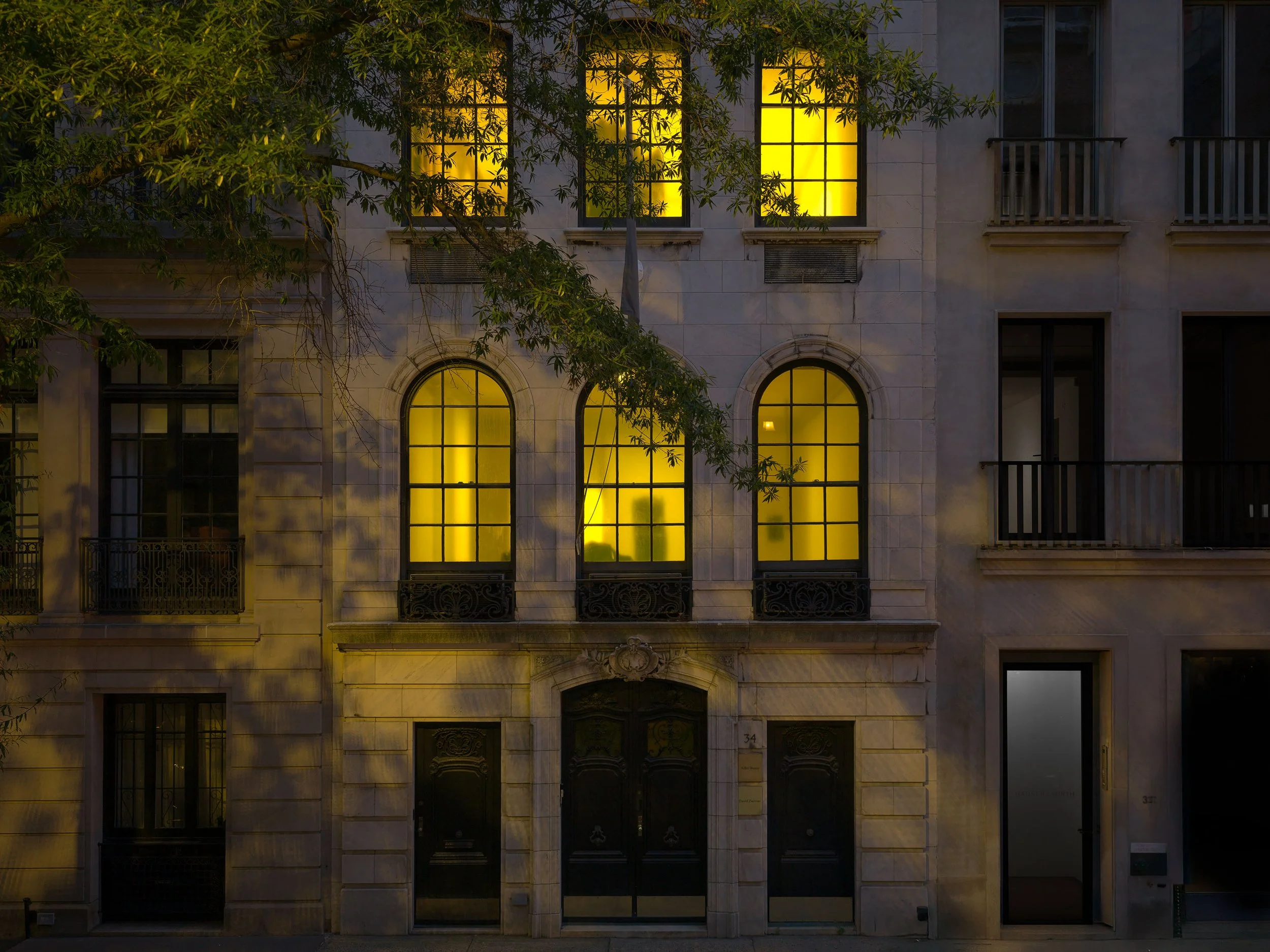Control Environment
Humans exert power over objects by naming them. The act of identifying something is the first step toward shaping and controlling it. By placing an object in taxonomy—transforming it into a symbol by establishing around it a meaning-system, a classification: an index, a matrix, a setting, a home—you inject it with meaning, implicitly seating yourself in the dominant position.
In Possessive, P. Staff’s debut New York solo exhibition across the three floors of David Zwirner’s uptown location, the bodiless armatures that compose the Distrain series (2025) embody the essential definition of the word “queer”: strange, unidentifiable, unknowable, unplaceable. Cast in their characteristic yellow miasma (a colder, more bilious expression of Blade Runner 2049’s dystopian Vegas haze), the objects do not look like identifiable figures, or even furniture. They resemble reproductions of primordial, pre-terrestrial creatures more than they do anything else. Glossy sheets of latex pool, drape, and strain over systems of rods—painted, oiled with latex polish, and arranged to mimic the specific materiality of metal, but made of wood—at points zip-tied and bound into solid, satisfying nubs and angles. At large, the site-specific installation becomes a townhouse-body haunted by these organic suggestions: a liminal space at once ancient and contemporary, jellied and diaphanous, fixed and in transition, in some places slack, in some places stretching the limits of its skin.
Penetration (2025), a looped film that presents, against the building’s spinal column, an anonymous silhouette primarily washed in a shade that approaches International Klein Blue and its legacy of body-based image-making, is the most human and least erotic part of the show. This figure, split in thirds across the landings, is a decision that echoes the evolution of the three-dimensional works and associated concept-progression as the viewer ascends, breathes, and smokes evenly, at odds with its soundscape. We see a constant rhythm but hear ambient irregularity, creaks and discordant notes and an off-kilter heartbeat; a thin laser-green line spills into a puddle above the waistband of the body’s boxers, truncated by the demarcation of the second floor. In the context of its surroundings, this last action becomes so explicit that it fails to land. A projection simply cannot be penetrated or even cut by a ray of light, however piercing, though the two can and do meet in a futile caress, producing the ethereal appearance of touch if not the material weight of feeling itself. In a classic transmutation of desire, that feeling is deferred onto the glorious and abject objects of Distrain 1–10 (save 4 and 8).
“Everything is about sex, except for sex. Sex is about power,” goes the line attributed to Oscar Wilde. Staff’s objects certainly embrace the recognizable aesthetics of BDSM, the manifest extension of this corollary, which is often bluntly interpreted as accessorized sex. While the practice can involve auxiliary objects, its true function is to strip practitioners down to essential, elemental forms: game theory, the skeletal framework of give and take, the power differential. It is the superstructure that reveals and clarifies the substructure. Everything is just about power, which is perhaps an ugly reality, but one that houses inherent tensile contradictions crucial to the production of beauty. Welcome to New York!
Staff’s sculptures, the superstructural muscle of the installation (plus its scaffolding, which has been left visible: speakers, projectors, and their own systems of supports), tie Possessive to the architecture of the gallery space itself. In their contortions, slick surfaces, and suggestive absences, they reflect the deliberately transposed dimensions and qualities of their home: its walls and arch-topped windows, its ornamental fireplaces, mirrors, and gridded parquet floors. By identifying and reproducing elements of the environment they occupy, they come to possess it. They represent a kind of evolutionary process—learning to fit an ecological niche, to properly inhabit a constructed ecosystem, the “concrete jungle”—in microcosm.
This show rewards patient, intimate, durational looking; it was only on my third visit that I discovered how it begins as soon as you enter the building. Staff’s signature light colors the foyer, which I had originally rushed through, establishing in this initial, windowless pre-room an aqueous chthonia. From these depths, you climb the flowery wrought-iron spiral staircase, which finds its outline mirrored in the fanlike sail of Distrain 10 (2025), the largest and most beautiful of the series on display, perched on the third floor behind a door that is partially closed some of the time. Increased access to light renders these particular objects—higher up the phylogenetic tree, the aesthetic food chain—more transparent and romantic than their compact, opaque, relatively basement-dwelling kin. Still, Staff communicates an overall feeling of interdependence through their visual vernacular of repetition: per Donald Kuspit’s seminal 1988 Artforum feature, which notes the polish and fluid temporality of “the modern fetish,”[1] even the yellow films pasted over the windows reinforce the provocative oleic gleam shared by all of the installation’s interior structures, beautiful and ugly alike.
In a gesture toward the external dimension of language, the show’s name is specific—and ultimately quite powerful. Possessive is a feeling, a quality of being like an ineffable quality of light. Like a mutualistic parasite, the installation feeds off the built conventions of its host-body while enhancing and redefining the fundamental meaning of its substrate: the gallery, the site itself. Within rigid codes of classification, the subversive abstractions of queerness enable and produce nuanced freedoms of looking and expression: the right to be seen, to have and to hold, to choose precisely how to control and be controlled, to feel and fill a space in unplaceable ways. Obviously, as ever, it helps to have the real estate.
P. Staff: Possessive is on view at David Zwirner East 69th Street from September 18 through October 25, 2025.
[1] Donald Kuspit, “The Modern Fetish,” Artforum 27 no. 2 (October 1988).




